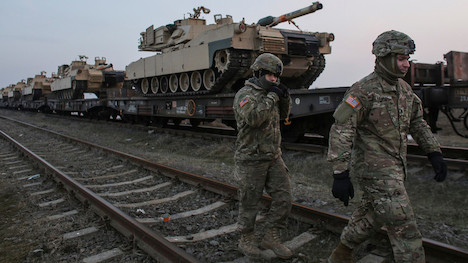US military complex is a ‘malignant virus’ that's evolved to defend itself
 Print This Print This
By Staff Writers | RT
RT.com
Friday, May 31, 2019
 |
| FILE PHOTO © Reuters / Inquam Photos / Octav Ganea |
The US military industrial complex has grown into a self-sustaining organism with an immune system that attacks and smothers any threat to its food supply – the taxpayers' money, writes renowned defense analyst Andrew Cockburn.
Cockburn outlines the process that allows US defense contractors to thrive despite repeatedly missing deadlines and producing overpriced, subpar equipment. The system has evolved to be very good at defending itself – while leaving the country, “in reality so poorly defended,” he writes in his latest think piece for Harper's Magazine titled ‘The Military-Industrial Virus: How bloated defense budgets gut our armed forces’.
Cockburn, whose 40+ years of experience include numerous books and publications on the US' military complex, its foreign wars and adversaries, looks at the current state of America's armed force – from the overpriced “disaster” that is the F-35 fighter, to the few “dilapidated” minesweepers, to faulty personal protection and radios American soldiers are equipped with – and compares it to the exorbitant defense bills the taxpayer has to foot.
The MIC is embedded in our society to such a degree that it cannot be dislodged, and also that it could be said to be concerned, exclusively, with self-preservation and expansion, like a giant, malignant virus.
The system's “beauty,” he ironically points out, “lies in its self-reinforcing nature.” Every new system, weapon, or piece of equipment, costs up to twice as much as the one it's built to replace, and is often either plagued by bugs that have to be fixed (for additional money), or is straight-up worse than the predecessor. Busted deadlines and post-rollout fixes then inflate the costs even further, lining the defense contractors' pockets.
With this in mind, defense spending has been growing at a steady pace since World War II, and when there's talk of slashing that growth, a perceived 'threat' emerges to justify bumping it up. This was the case with the “fraudulent specter” of the “missile gap” with the Soviet Union during the Cold War, or the war in Vietnam.
Opposition to the exorbitant spending among Washington's politicians is muted and misdirected, Cockburn writes. Even those who are against it, like Rep. Ro Khanna (D-California), tend to focus on the “misuse of our military power,” not the apparent fact that its use is driven first and foremost by MIC revenues – not the other way around. US President Donald Trump's recent attempt to reduce the growth of defense spending by proposing a $700 billion budget for 2020 was an “aberration,” quickly corrected to $750 billion.
Cockburn's arguments ring especially true as Washington gears up for a stand-off with Iran, sending warships, nuclear-capable bombers and reportedly preparing a 120,000-strong force for a possible Middle East showdown. He points to the absence of military parades in the US – but what's a parade, in terms of showcasing military might (and the money at work), compared to a live-fire demonstration with an ‘adversary’ on the receiving end?
Source URL
|
 Print This Print This

|

